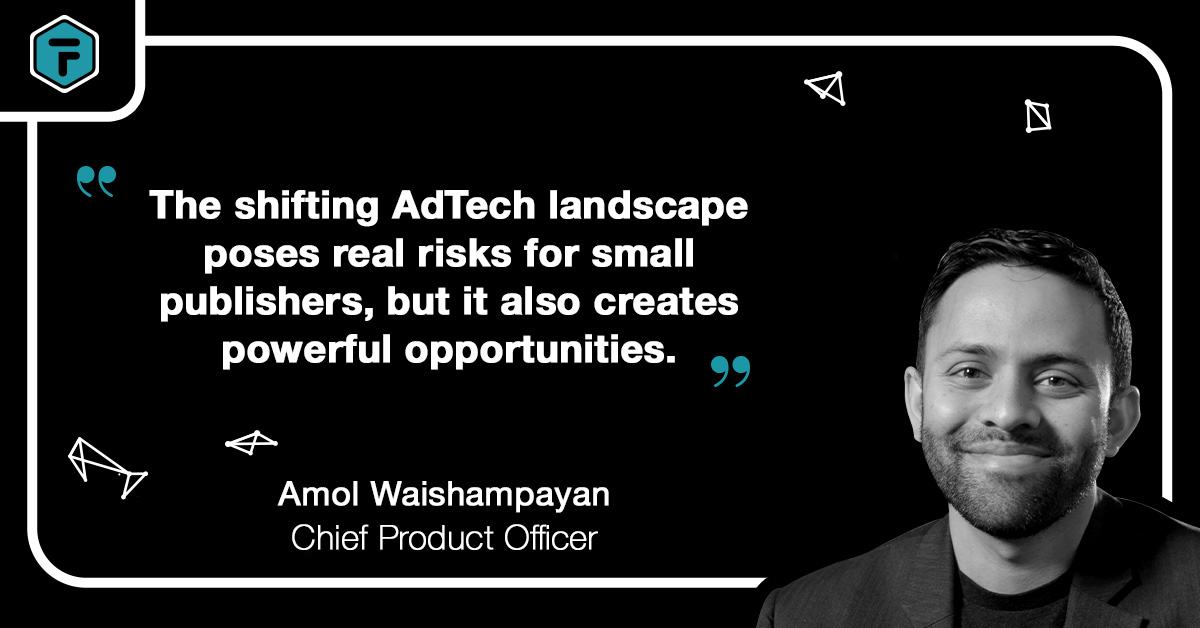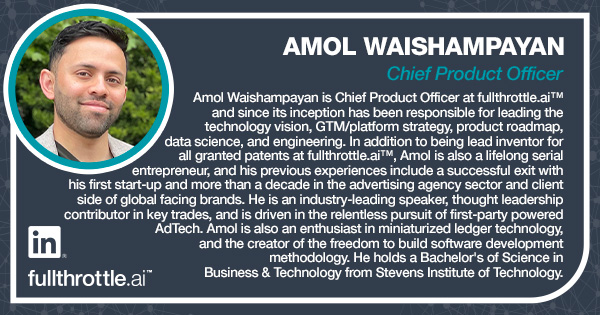
By: Amol Waishampayan, Chief Product Officer
Essential Strategies for Small Publishers in a New Era
Small publishers find themselves at a crossroads, facing uncertainty and challenges that can make or break their success. Adaptation and innovation are no longer just buzzwords — they're the keys to survival. As cookie-based marketing and list-buying begin to lose effectiveness, how can small publishers continue to drive traffic, identify site visitors, and generate actionable data that helps them expand their audience?
Key takeaways:
- Quality content is essential for building trust with your audience and collecting valuable first-party data.
- Employ opt-in, privacy-safe methods, such as fullthrottle.ai® transformation technology, newsletters, webinars, surveys, and interactive content, to build first-party data.
- Enhance the user experience by focusing on intuitive navigation, responsive design, fast load times, personalized content, and accessibility.
- Leverage social media to expand your reach, build community, and promote your content through strategic techniques, like using hashtags, collaborating with influencers, hosting contests, and sharing user-generated content.
- Utilize analytics tools and establish KPIs to make data-driven decisions, optimize website performance, and refine content strategy.
Quality Data = Quality Content
It would be a mistake to start any article on how small publishers can weather the AdTech storm without mentioning quality content. It’s the lifeblood of a publisher’s business and the foundation for building a loyal following. There’s another benefit to this approach, however: by establishing your website as a credible source of information, your audience will be more likely to trust you with their first-party data.
First-party data, which comes directly from your website's visitors, can be a goldmine of information that helps you refine your content strategy and build a loyal readership. This type of data includes user behavior, preferences, and engagement with your content. By understanding what types of content your audience finds most appealing, you can focus on producing more of it, thereby attracting more interested visitors to your site. This, in turn, can help you build a larger and more engaged audience, as these visitors are more likely to share your content and recommend your website to others.
How You Can Build More Valuable First-Party Data
With the public’s shifting attitudes toward privacy and transparency around data collection, third-party cookies and list-buying are part of the past. Don’t worry, though — opt-in, privacy-safe methods can be even more effective in helping you understand your audience.
- Partner with a data generation platform: fullthrottle.ai® uses opt-in location data to identify site visitors. It’s a seamless way to re-engage with your audience and build first-party data that your brand owns.
- Offer a newsletter or email subscription: Just because list-buying is out doesn’t mean you can’t build your own. Encourage visitors to your website to sign up for your newsletter or email distribution. This will allow you to collect their email addresses and other relevant information.
- Host webinars or events: Host events and webinars and ask attendees to register beforehand. This will allow you to collect data about their interests, job titles, locations, and more.
- Conduct surveys: Place surveys on your website or social media platforms to gather data about your audience's preferences, interests, and behaviors.
- Create interactive content: Create quizzes, polls, and other interactive content that requires users to provide their email address or other information in exchange for access to the content.
- Use social media: Use social media to engage with your audience and encourage them to provide their information in exchange for exclusive content or offers.
User Experience — Keeping Visitors Engaged and Coming Back
User experience is a critical aspect of any website, especially for small publishers looking to retain their audience and encourage repeat visits. By offering a seamless, enjoyable experience for your site visitors, you'll not only keep them engaged but also inspire them to share your content with others. The more word-of-mouth recommendations you receive, the less you have to rely on outdated or invasive data collection methods.
Tips for Creating a Joyful User Experience on Your Site
Here are some key factors to consider when optimizing your website's user experience:
Intuitive navigation: Make it easy for users to find and access the content they're interested in. Organize your site logically, with clear menus, categories, and search functionality.
Responsive design: Ensure your website is accessible and visually appealing on various devices, including desktops, tablets, and smartphones. Responsive design will help improve your search engine rankings too. Search engines favor mobile-friendly sites.
Fast load times: Slow-loading websites can frustrate users and lead to higher bounce rates. Optimize your site's performance by compressing images, using caching techniques, and reducing the use of heavy scripts.
Personalized content: Use the first-party data you've collected to offer personalized content recommendations and tailored user experiences. This will help you build deeper connections with your audience and increase engagement.
Accessibility: Make your website accessible to users with disabilities by adhering to web accessibility guidelines. This not only fosters a more inclusive experience but can also improve your search engine rankings.
Social Media — Expanding Your Reach and Building Community
Social media has become an indispensable tool for small publishers looking to expand their reach, engage with their audience, and build a sense of community around their brand. While traditional comment sections are still beneficial, social media adds the potential for greater reach to the relationship between readers and content creators.
Brands like Buzzfeed and Vox prove that interactivity breeds loyalty. By leveraging social media platforms, you can not only promote your content but also foster valuable connections and drive traffic to your website.
Practical Ways To Build Community Using Socials
Everyone talks about why social media is useful, but few talk about the what and the how. Beyond simply sharing and interacting, here are some things you can do to expand your reach and build a strong community:
- Utilize hashtags and keywords: Use popular and relevant hashtags and keywords in your social media posts to increase their visibility and reach. This will help you attract new followers and drive traffic to your website.
- Collaborate with influencers: Partner with influencers in your niche to expand your reach and credibility. This can include guest posts, interviews, and collaborations on content that will resonate with both your audience and the influencer’s.
- Host contests and giveaways: Run contests, giveaways, and promotions on your social media channels to encourage user engagement, attract new followers, and generate buzz around your brand. (Plus, it’s a great way to gather first-party data!)
- Share user-generated content: Encourage your audience to share their own content related to your brand, such as photos, videos, and testimonials. Share the best submissions on your social media channels to showcase your community and foster a sense of belonging.
- Leverage social media advertising: Use targeted social media advertising to reach a larger audience and drive traffic to your website. Experiment with different ad formats and targeting options to find the most effective strategy for your brand.
One more note when it comes to advertising on social media: the most difficult problem to solve around social ads is attribution. How do you know that your ad dollars directly contributed to a sale? Sure, you can see the ad’s clickthrough rate — but what if they liked what they saw and bought a subscription later, all without clicking the ad? fullthrottle.ai® solves this problem by identifying site visitors along with every marketing message they experienced before buying. If you want to truly understand the journey a visitor takes, you need an attribution model that considers each touchpoint and ties them all back to business transactions.
Analytics and Measurement — Making Data-Driven Decisions
Tracking and analyzing website traffic and user behavior is crucial for understanding what works and what needs improvement, but tracking isn’t as simple as it once was. As we move towards a privacy-conscious future, it’s important to adapt to new methods that respect user choice, while giving you the edge you need as a small publishing business in a competitive environment. By utilizing analytics tools and monitoring key performance indicators (KPIs), you can make data-driven decisions that help optimize your website performance, enhance user experience, and refine your content strategy.
How To Step Up Your Analytics Game
- Define your KPIs: Identify the key performance indicators that are most relevant to your business objectives. These can include metrics such as pageviews, bounce rate, time on site, conversion rate, and social media engagement. By monitoring your KPIs, you can track your progress and make data-driven decisions to improve your website's performance.
- Segment your data: Break down your analytics data into segments based on factors like demographics, user behavior, and traffic sources. This will help you identify trends and patterns, as well as uncover areas of opportunity for growth and improvement.
- Set up custom reports: Create custom reports in your analytics tool to track the KPIs that matter most to your business. This will allow you to quickly access the data you need to make informed decisions and monitor your website's performance.
- Conduct A/B testing: Use A/B testing to experiment with different website elements, such as headlines, images, and calls-to-action. By comparing the performance of different variations, you can optimize your site for better user experience and conversion rates.
- Monitor and analyze social media data: Track your social media performance by monitoring engagement metrics, such as likes, shares, comments, and click-through rates. Use this data to inform your social media strategy and improve your content's reach and impact.
The Future of Actionable Audience Data for Small Publishers
The shifting AdTech landscape poses real risks for small publishers, no doubt—but it also creates powerful opportunities. Small publishers who dedicate their brand to quality content, a pleasant user experience, community-building through social media, and quality analytics stand to gain a fiercely loyal following. It’s time to leave third-party cookies and trackers in the past (they weren’t so great anyway).
At fullthrottle.ai®, we're committed to helping publishers build loyal audiences through transparent and opt-in first-party data. The patented AdTech powering fullthrottle.ai® gives your brand a goldmine of data that you own, allowing you to identify site visitors and reach excited readers you never had access to before. Our platform acts as a force multiplier on your current advertising efforts by transforming previously unreachable site visitors into addressable households. Book a demo to see it in action.




